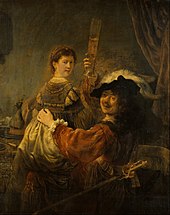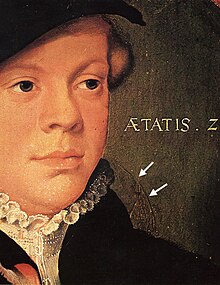Pentimenti
Pentimenti ( plural , from Italian pentimento , "remorse"; German "reuestriche", Germanized also pentiment ) are changes that were made to graphics, paintings or wall paintings during the artistic creation process. Pentimenti arise because during this process the artist wrestles with line, shape and color for what he believes is the ideal representation of his "pictorial idea". Lines are corrected, shapes are painted over and colors are changed. Pentimenti can appear in all layers of a work of art that are subject to this creation process. So in the signature , between the signature and the color design and in the individual layers of color of an image layer. Pentimenti are used in oil paintings etc. a. recognizable due to the age transparency of the color layers. Sometimes they can also be detected with the help of UV rays, IR rays and / or X-rays . By reproducing the working process of an artist, they form an essential source for the genesis of a painting.
Examples
In the painting Rembrandt and Saskia in the parable of the prodigal son ( Gemäldegalerie Alte Meister , Dresden) by Rembrandt van Rijn , several areas have been painted over and the canvas has been trimmed or attached. There are two more female figures on the preliminary drawings. Behind Rembrandt and Saskia was a lute player who is now covered by the feathers of the peacock pie and could be detected in x-rays. This, as well as symbols still preserved in the picture, such as a notice board on the left edge of the picture, are clear indications of a bar or brothel scene that is assigned to the biblical parable of the prodigal son, in whose role the artist shows himself. He celebrates with prostitutes in the tavern, where he squanders his inheritance.
literature
- Knut Nicolaus: paintings. Investigated-Discovered-Erforscht, Braunschweig 1982
Individual evidence
- ↑ Albert Knoepfli; Oskar Emmenegger: Wall painting up to the end of the Middle Ages. In: Reclam's Handbook of Artistic Techniques, Volume 2, Wall Painting and Mosaic. Philipp Reclam jun. Stuttgart, 1990, ISBN 3150103452 , p. 82.
- ^ Pentimento. In: Angela Weyer et al. (Ed.): EwaGlos. European Illustrated Glossary Of Conservation Terms For Wall Paintings And Architectural Surfaces . English Definitions with translations into Bulgarian, Croatian, French, German, Hungarian, Italian, Polish, Romanian, Spanish and Turkish. Michael Imhof, Petersberg 2015, ISBN 978-3-7319-0260-7 , p. 90 , doi : 10.5165 / hawk-hhg / 233 ( download ).

